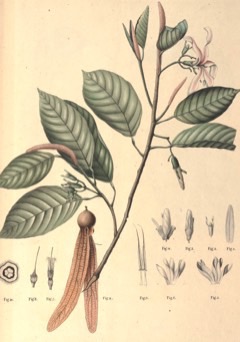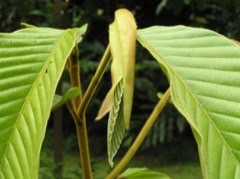 |
|
edibleplants.org |
 |
| ? Angela Hijjas www.rimbundahan.org |
Translate this page:
Summary
Physical Characteristics

 Dipterocarpus gracilis is an evergreen Tree growing to 50 m (164ft) by 35 m (114ft) at a medium rate.
Dipterocarpus gracilis is an evergreen Tree growing to 50 m (164ft) by 35 m (114ft) at a medium rate.
See above for USDA hardiness. It is hardy to UK zone 10. The flowers are pollinated by Insects.
Suitable for: medium (loamy) and heavy (clay) soils, prefers well-drained soil and can grow in heavy clay soil. Suitable pH: mildly acid and neutral soils. It can grow in semi-shade (light woodland) or no shade. It prefers moist soil.
UK Hardiness Map
US Hardiness Map
Synonyms
Anisoptera palembanica Miq. Dipterocarpus angustialatus Heim Dipterocarpus bancanus Burck Dipterocarpus fulvus Blume Dipterocarpus marginatus Korth. Dipterocarpus pilosus Roxb. Dipterocarpus schmidtii Heim Dipterocarpus skinneri King Dipterocarpus vernicifluus Blanco
Plant Habitats
Edible Uses
References More on Edible Uses
Medicinal Uses
Plants For A Future can not take any responsibility for any adverse effects from the use of plants. Always seek advice from a professional before using a plant medicinally.
The oleo-resin and also the bark of the tree have medicinal properties[418 ].
References More on Medicinal Uses
The Bookshop: Edible Plant Books
Our Latest books on Perennial Plants For Food Forests and Permaculture Gardens in paperback or digital formats.

Edible Tropical Plants
Food Forest Plants for Hotter Conditions: 250+ Plants For Tropical Food Forests & Permaculture Gardens.
More

Edible Temperate Plants
Plants for Your Food Forest: 500 Plants for Temperate Food Forests & Permaculture Gardens.
More

More Books
PFAF have eight books available in paperback and digital formats. Browse the shop for more information.
Shop Now
Other Uses
A balsam resin is obtained from the trunk[46 ]. It is used in paint oils; as a coat for waterproofing paper; as a varnish for boats, walls and furniture.[46 , 418 ]. The resin is obtained by cutting a hole in the trunk near the base (about 90 - 150cm from the ground) and then dipping out the resin with a spoon as it collects there. To prolong the flow, a fire made from dead leaves or brushwood is made in the hole at intervals - this burns off the dried resinous film and allows the resin to flow again[64 , 146 ]. Dammar is a hard resin, obtained from various trees of Southeast Asia. Traditionally, it is used for purposes such as caulking boats and baskets, as an adhesive, a medicine, as a fuel for torches and sometimes in foods. Dammar has many commercial applications, though many of these uses are less important nowadays due to the advent of synthetic materials. Commercially, it is an ingredient of inks, lacquers, oil paints, varnishes etc, and is used as a glazing agent in foods[891 ]. Harvesting of the resin commences when the bole is around 25cm in diameter (approx 20 years old). Triangular cuts (becoming circular with age) are arranged in vertical rows around the trunk. The cuts are several centimetres wide at first, but become enlarged at every tapping and eventually become holes of 15 - 20cm in depth and width. The average number of holes for a tree about 30 metres tall and 60 - 80cm in diameter is 9 - 11 in each of 4 - 5 vertical rows. For the higher holes, the tapper climbs the tree supported by a rattan belt and using the lower holes as footholds. The exuded resin is allowed to dry on the tree before it is collected. The frequency with which the tree is visited to refreshen the cut varies from once a week to once a month, depending on how far the tree is from the village. Tapping can continue for 30 years[891 ]. The light-red wood is heavy, moderately hard and close-grained, but not very durable in contact with the ground[46 , 418 ]. It saws well, but is not used for boxes because of the resin it contains[146 ]. It is used for house construction[46 ]. Because of its resinous nature it is less suitable for flooring and woodwork exposed to the sun[418 ]. It is one of the important sources of keruing timber in Indo-China and is often used as a commercial grade plywood[338 ]. The wood can be used to make charcoal[418 ]. The tree is a source of keruing timber[721 , 884 ]. We do not have any more specific information for this plant, but a general description of the wood is as follows:- The heartwood varies from light to dark red-brown or brown to dark brown, sometimes with a purple tint; it is usually well defined from the 5 - 7cm wide band of gray or buff sapwood. The texture is moderately coarse; grain straight or shallowly interlocked; lustre low; there is a strong resinous odour when freshly cut, it is without taste. The wood is moderately heavy to heavy; moderately hard; somewhat durable, being resistant to dry wood borers, fairly resistant to fungi but susceptible to termites, though silica content may be high, resistance to marine borers is erratic. It seasons slowly, with a high risk of checking and distortion; once dry it is poorly stable to moderately stable in service. Silica content is variable, generally less than 0.5%. The wood generally saws and machines well, particularly when green; blunting of cutters can be moderate to severe due to silica content, stellite-tipped and tungsten carbide tools are recommended; it is sometimes difficult to glue; resin adhering to machinery and tools may be troublesome and can also interfere with finishes; nailing and screwing are good, but require pre-boring; gluing is correct, but care is required because of the resin. The wood is used for general construction work, carpentry, panelling, joinery, framework for boats, flooring, pallets, chemical processing equipment, veneer and plywood, suggested for railroad crossties if treated[303 , 316 , 848 ].
Special Uses
Carbon Farming
References More on Other Uses
Cultivation details
Industrial Crop: Hydrocarbon Management: Standard Wild Crop
A tree of low to moderate elevations in the moist tropics, where it can be found at elevations up to 1,200 metres. It grows best in areas where annual daytime temperatures are within the range 24 - 32°c, but can tolerate 10 - 40°c[418 ]. It can be killed at temperatures of 5°c or lower[418 ]. It prefers a mean annual rainfall in the range 1,500 - 3,000mm, but tolerates 500 - 4,500mm[418 ]. Young trees are shade tolerant, but become increasingly light demanding as they grow larger. Prefers a medium to heavy soil[418 ]. Prefers a pH in the range 5 - 6, tolerating 4.5 - 6.5[418 ]. Members of this genus generally only regenerate naturally in the shade of the forest. Seedlings and saplings can persist in dense forest shade for many years. In their first 2 years the young plants cannot tolerate major openings in the canopy, but after they are well established (about 120cm tall) the canopy can be opened up around them to speed up their growth[404 ].
Carbon Farming
-
Industrial Crop: Hydrocarbon
Materials, chemicals and energy include bioplastics, rubber, biomass products gasoline, jet fuel, diesel, butane, propane, biogas. Plants are usually resprouting plants and saps.
-
Management: Standard
Plants grow to their standard height. Harvest fruit, seeds, or other products. Non-Destructive management systems.
-
Wild Crop
Some wild plants have strong historical or contemporary use. Although they are not cultivated crops, they may be wild-managed.
References Carbon Farming Information and Carbon Sequestration Information
Temperature Converter
Type a value in the Celsius field to convert the value to Fahrenheit:
Fahrenheit:
The PFAF Bookshop
Plants For A Future have a number of books available in paperback and digital form. Book titles include Edible Plants, Edible Perennials, Edible Trees,Edible Shrubs, Woodland Gardening, and Temperate Food Forest Plants. Our new book is Food Forest Plants For Hotter Conditions (Tropical and Sub-Tropical).
Shop Now
Plant Propagation
Seed. Members of this genus generally only regenerate naturally in the shade of the forest. Seedlings and saplings can persist in dense forest shade for many years. In their first 2 years the young plants cannot tolerate major openings in the canopy, but after they are well established (about 120cm tall) the canopy can be opened up around them to speed up their growth[404 ].
Other Names
If available other names are mentioned here
Borneo: Damar kumbang, Kaladan, Keruing, Keruing kesat, Keruwing daun kecil, Kruwing, Pudan, Tempurau. Java: Wuluk bulan. Malaysia: Keruing kesat, Keruing bungoh, Keruing daun halus. Philippines: Agan-an (Bicol.), Duha (Ibn.), Kurimau (Ibn.), Lalian (Tag.), Lanutan (Neg.), Lauan (Zamb., Sul.), Pagsa hingau (Tag.), Palemopang (Tag.), Palohap (Sbl.), Pamalalian (Cag., Ibn.), Pamantulen (Ilk.), Pamantuling (Pang.), Pamarnisen (Ibn.), Panao (Tag., Pang., Sbl., Ibn., Pamp.), Putsa hingan (Tag.), Sitam (Ibn.). Sumatra: Bembang.
Native Range
TROPICAL ASIA: Bangladesh, India (Andaman and Nicobar Islands), Myanmar, Thailand, Indonesia (Jawa (west), Kalimantan, Sumatera), Malaysia, Philippines
Weed Potential
Right plant wrong place. We are currently updating this section.
Please note that a plant may be invasive in one area but may not in your area so it's worth checking.
None Known
Conservation Status
IUCN Red List of Threatened Plants Status : Status: Critically Endangered A1cd+2cd

Growth: S = slow M = medium F = fast. Soil: L = light (sandy) M = medium H = heavy (clay). pH: A = acid N = neutral B = basic (alkaline). Shade: F = full shade S = semi-shade N = no shade. Moisture: D = dry M = Moist We = wet Wa = water.
Now available:
Food Forest Plants for Mediterranean Conditions
350+ Perennial Plants For Mediterranean and Drier Food Forests and Permaculture Gardens.
[Paperback and eBook]
This is the third in Plants For A Future's series of plant guides for food forests tailored to
specific climate zones. Following volumes on temperate and tropical ecosystems, this book focuses
on species suited to Mediterranean conditions—regions with hot, dry summers and cool, wet winters,
often facing the added challenge of climate change.
Read More
Expert comment
Author
Blume
Botanical References
Links / References
For a list of references used on this page please go here
A special thanks to Ken Fern for some of the information used on this page.
Readers comment
| Add a comment |
|
If you have important information about this plant that may help other users please add a comment or link below. Only comments or links that are felt to be directly relevant to a plant will be included. If you think a comment/link or information contained on this page is inaccurate or misleading we would welcome your feedback at [email protected]. If you have questions about a plant please use the Forum on this website as we do not have the resources to answer questions ourselves.
* Please note: the comments by website users are not necessarily those held by PFAF and may give misleading or inaccurate information.
To leave a comment please Register or login here All comments need to be approved so will not appear immediately.
|
Subject : Dipterocarpus gracilis
|
|
|
|